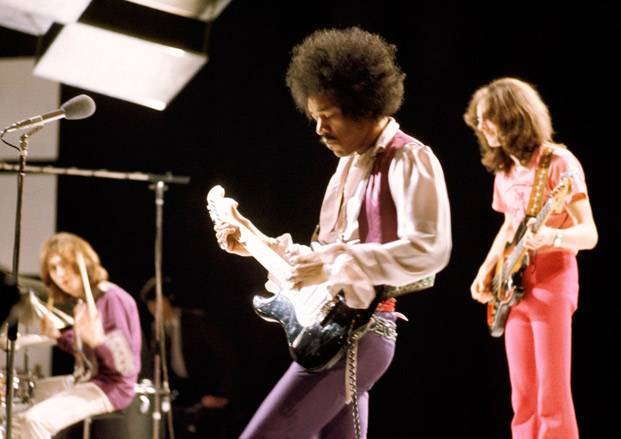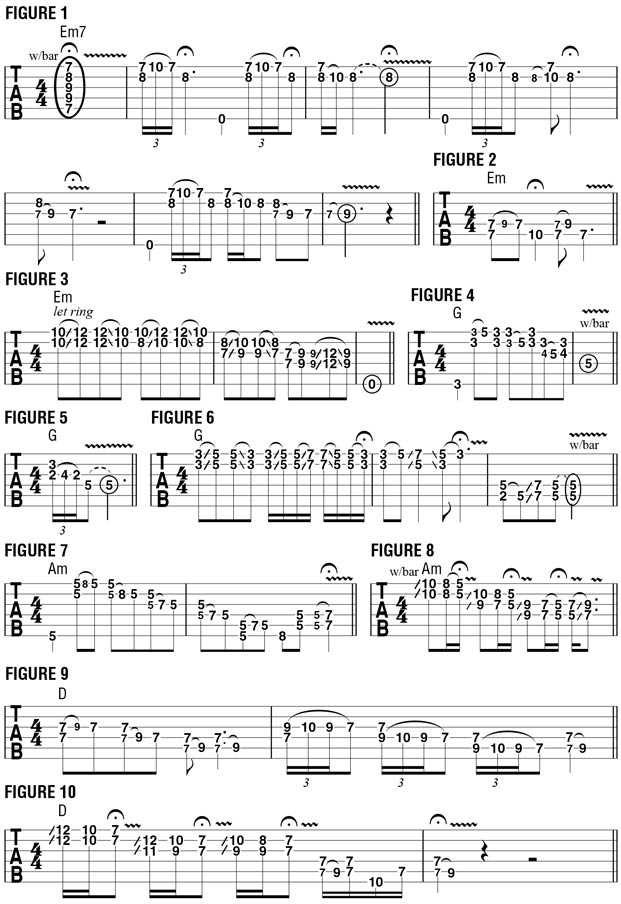How to Play Jimi Hendrix-Style Rhythm Guitar
Learn a few of the rhythm guitar techniques Jimi would most often employ to spice up his rhythm parts and make them melodic.

Jimi Hendrix was nothing less than a complete guitarist. He was a brilliant and seemingly effortless performer, improviser, songwriter and innovator, and an equally brilliant rhythm player, which is an aspect of his musicianship that is sometimes overlooked. In this month’s column, I’d like to demonstrate a few of the rhythm guitar techniques Jimi would most often employ to spice up his rhythm parts and make them melodic.
Let’s begin with a standard seventh-position Em chord, with the E root note sounded on the fifth string’s seventh fret, as shown in bar 1 of FIGURE 1. I refer to this as a “fifth-string-root” barre chord.
Jimi utilized this voicing quite often; his masterpiece, “Little Wing,” is a great example of a song in which he employed this voicing quite often. Jimi liked to embellish his chords by using his pinkie to sound higher notes on each of the strings, enabling him to create little melodic fills that served to make the rhythm parts much more interesting. In bars 2–7 of this example, I use my pinkie to add and remove certain notes while moving from the first string across to the third. As you can see, I use both hammer/pulls and straight hammer-ons to sound these extra notes off the chord shape. I can further expand these fills to the D and A strings, as demonstrated in FIGURE 2.
Another technique Hendrix employed to great effect, and one that I love to borrow, is to slide a pair of notes up and down the neck on two adjacent strings. FIGURE 3 demonstrates this technique, with note pairs sliding up and down various string pairs.
Now let’s take a six-string-root major barre chord and try a similar embellishing approach. In FIGURE 4, I begin with a G major voicing wherein the low G root note on the sixth string is fretted with the thumb—another signature Hendrix rhythm playing technique. This will free up the rest of the fretting fingers to add chord embellishments. As I had demonstrated earlier over Em, I can add higher notes with the pinkie on the top three strings to create more complex rhythm figures.
FIGURE 5 offers another of Jimi’s favorite techniques, which is to begin by fretting the second and fifth of the chord and then hammering on from the second to the third with the ring finger. As I had done over Em in FIGURE 3, FIGURE 6 offers finger slides performed on adjacent pairs of strings, based on the G chord shape.
If we move up two frets to Am, we can bring these same techniques into play, as configured for a six-string-root minor chord (see FIGURES 7 and 8). And lastly, you could apply this approach to a fifth-string-root D major chord, as shown in FIGURES 9 and 10. Now that you know how to embellish both minor and major chords, try incorporating these ideas in your favorite songs.

Get The Pick Newsletter
All the latest guitar news, interviews, lessons, reviews, deals and more, direct to your inbox!









![Joe Bonamassa [left] wears a deep blue suit and polka-dotted shirt and plays his green refin Strat; the late Irish blues legend Rory Gallagher [right] screams and inflicts some punishment on his heavily worn number one Stratocaster.](https://cdn.mos.cms.futurecdn.net/cw28h7UBcTVfTLs7p7eiLe.jpg)
